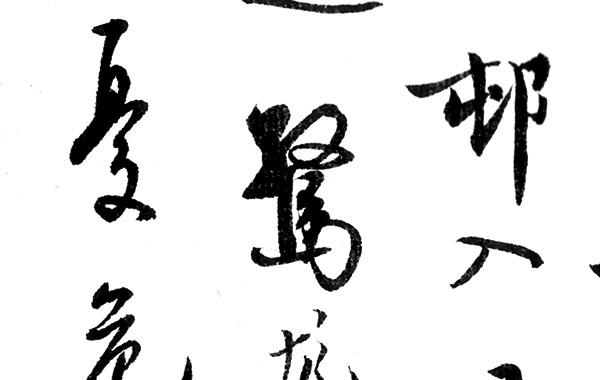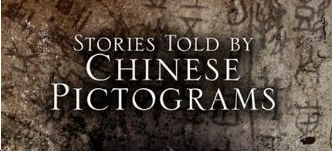From written word to art

Beginning of the written word
Language and words are tools used by the human race to express feelings and ideas. Before language and words were invented, people originally could only express themselves via body language. But the human mind and emotions are extremely complex compared to the somewhat simple and limited forms of the body language, and thus people started to use sound as a way to express, and it developed into language. Later, it was realised that sound still had limitations; it was difficult to get messages across a distance as message can be very distorted after passing down from one to another. As life span and memory are limited and after a while things disappear from the memory, so people thought of tieing knots on ropes to record things and drawing pictures to send messages to people far away. This is when visual communication started to influence human lives.
Written words as visual communication
Graphic Design and Chinese Calligraphy are both thoughts made visible, ideas, feelings or wisdom are communicated visually. Although I don’t know a lot about the art of Chinese Calligraphy, but visually it interests me a great deal, and made me want to learn from it to enhance my practice in the profession of graphic design.
I believe that any graphic aware person would also be fascinated by the Chinese characters. Standing from a designer point of view I find Chinese characters most fascinating in terms of composition. There are about 80,000 characters, each one to be unique in terms of composition, and designed with a simple purpose – to communicate.
From drawings to words – The development of Chinese characters
 People make Culture, culture make country, and country relies on people. It is natural behavior that human beings learn from each other, and this learning process should enhance the way we live. Culture is the result of combining and rearranging of two or more of the better things together to form a new entity. Comparing is a powerful act, it is through comparison that we realize the better one amongst a number of candidates, this realization is then put into action, and the result is what we call ‘improvement’. The development of Chinese character is most fascinating, and has a close relationship in the act of art making. Because of its long history, improvement, refinement and the designing of new characters took place over this long period of time. Ancient characters looked different from the modern ones we use today; they were drawings of objects, that we call pictogram. They are refined and made into abstract forms, the basic word-unit and building blocks of the Chinese language. Each Chinese character is organized within the boundaries of a square and is conceived of and executed as an independent entity. Composed out of a number of orderly strokes, every character in the extensive Chinese vocabulary poses a unique design problem in terms of its internal structure and its relationship to the characters surrounding it.
People make Culture, culture make country, and country relies on people. It is natural behavior that human beings learn from each other, and this learning process should enhance the way we live. Culture is the result of combining and rearranging of two or more of the better things together to form a new entity. Comparing is a powerful act, it is through comparison that we realize the better one amongst a number of candidates, this realization is then put into action, and the result is what we call ‘improvement’. The development of Chinese character is most fascinating, and has a close relationship in the act of art making. Because of its long history, improvement, refinement and the designing of new characters took place over this long period of time. Ancient characters looked different from the modern ones we use today; they were drawings of objects, that we call pictogram. They are refined and made into abstract forms, the basic word-unit and building blocks of the Chinese language. Each Chinese character is organized within the boundaries of a square and is conceived of and executed as an independent entity. Composed out of a number of orderly strokes, every character in the extensive Chinese vocabulary poses a unique design problem in terms of its internal structure and its relationship to the characters surrounding it.
From written words to art – Chinese Calligraphy
‘Shu-fa’ (書法) is the term for Chinese calligraphy; it is a traditional fine art combined the art of painting, literature and philosophy, resulting in a unique and beautiful form of art.
Even though the brushstrokes must make intelligible patterns in order to be decipherable, rich compositional variations occur and are sought after. William Wilets has elegantly described the aesthetic difference between writing in letters and writing characters:
The basic units, out of which Western writing is composed, the letters of the alphabets are phonetic symbols and as such are simple in form, strictly limited in number, and relatively unchanging in appearance. Words are not more than linear combination of these continually recurring basic elements; it follows that words cannot hold any inherent visual interests, since their forms are determined not by principle of structural design, but by the amount and nature of the phonetic material they have to carry. Each Chinese character, on the other hand, is organized within the boundaries of a square, and is conceived of and executed as an organic whole. Notwithstanding, therefore, that the elements out of which it is compiosed– the brush-strokes– must make an intellectually intelligible pattern, and notwithstanding that certain combinations of brush-strokes do recur from one character to another, each separate characters in the amazingly rich Chinese vocabylary in fact constitutes a fresh problem in stuctural dynamics, an “adventure of movement” whose successful resolution is triumph of artistic management. And this, I maintain, is not a difference in degree, but an absolute difference in kind. (William Willetts, Chinese calligraphy: Its History and Aesthetic Motivation (Hong Kong: Oxford university Press, 1981)
 Writing is considered the most important skill one should master in the past, people spent all their lives practicing this form of art, as handwriting can decide for a person’s success or failure, in a Chinese saying “seeing ones writing as though seeing ones personality”. This is because a person’s calligraphy often could represent his level of scholastic achievements. In fact calligraphy was an important component in the ‘Ka-Geu’ (科舉) Civil Examination, because from ones hand writing, not only could one tell of the level of scholarship, but also it was possible to observe the personality behind, eg, whether the candidate was prudent and cautious, or rushed and careless.
Writing is considered the most important skill one should master in the past, people spent all their lives practicing this form of art, as handwriting can decide for a person’s success or failure, in a Chinese saying “seeing ones writing as though seeing ones personality”. This is because a person’s calligraphy often could represent his level of scholastic achievements. In fact calligraphy was an important component in the ‘Ka-Geu’ (科舉) Civil Examination, because from ones hand writing, not only could one tell of the level of scholarship, but also it was possible to observe the personality behind, eg, whether the candidate was prudent and cautious, or rushed and careless.
The long and colorful history can be a rich resource and an honoured cultural heritage but on the contrary it can be extremely difficult to break free from tradition; to create an original and a worthwhile work of art out of writing can be a challenging task!

